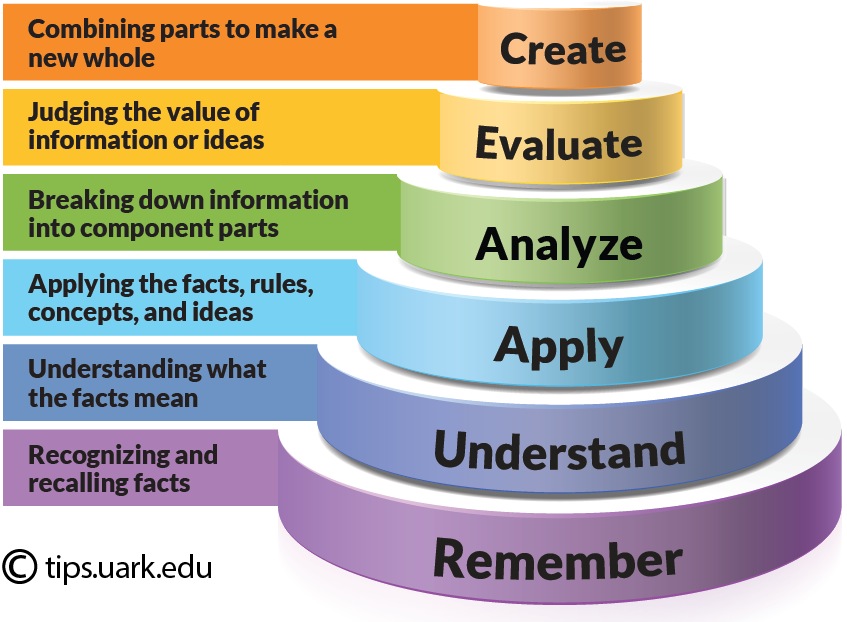Bloom’s Taxonomy, (in full: ‘Bloom’s Taxonomy of Learning Domains’, or strictly speaking: Bloom’s ‘Taxonomy Of Educational Objectives’) was initially (the first part) published in 1956 under the leadership of American academic and educational expert Dr Benjamin S Bloom. ‘Bloom’s Taxonomy’ was originally created in and for an academic context, (the development commencing in 1948), when Benjamin Bloom chaired a committee of educational psychologists, based in American education, whose aim was to develop a system of categories of learning behaviour to assist in the design and assessment of educational learning.
EXPLANATION OF BLOOM’S TAXONOMY
Taxonomy means
‘a set of classification principles’, or ‘structure’, and Domain simply
means ‘category’. Bloom’s Taxonomy underpins the classical ‘Knowledge,
Attitude, Skills’ structure of learning method and evaluation, Bloom’s
Taxonomy of Learning Domains remains the most widely used system of its kind in
education particularly, and also industry and corporate training. It’s easy to
see why, because it is such a simple, clear and effective model, both for
explanation and application of learning objectives, teaching and training
methods, and measurement of learning outcomes.
Bloom’s Taxonomy provides an excellent structure for
planning, designing, assessing and evaluating training and learning
effectiveness. The model also serves as a sort of checklist, by which
you can ensure that training is planned to deliver all the necessary
development for students, trainees or learners, and a template by which you can
assess the validity and coverage of any existing training, be it a course, a
curriculum, or an entire training and development programme for a large
organisation.
BLOOM’S TAXONOMY DEFINITIONS
Bloom’s Taxonomy model is in three parts.
1. Cognitive domain: Deals with the
intellectual capability, i.e., knowledge, or ‘think’.
2. Affective domain: Looks at the feelings, emotions and behaviour, i.e., attitude,
or ‘feel’.
3. Psychomotor domain: Deals with movements, Manual and physical skills, i.e., skills,
or ‘do’.
In each of the three domains Bloom’s Taxonomy is based
on the premise that the categories are ordered in degree of difficulty.
An important premise of
Bloom’s Taxonomy is
that each category (or ‘level’)
must be mastered before progressing to the next. As such the categories
within each domain are levels of learning development, and these levels
increase in difficulty. The learner should benefit from development of
knowledge and intellect (Cognitive
Domain); attitude and beliefs (Affective Domain); and
the ability to put physical and bodily skills into effect - to act (Psychomotor
Domain).
BLOOM’S TAXONOMY OVERVIEW
Here’s a really simple adapted ‘at-a-glance’
representation of Bloom’s Taxonomy. This simple overview can help you (and
others) to understand and explain the taxonomy. This overview helps to clarify
and distinguish the levels. For the more precise original Bloom Taxonomy
terminology and definitions see the more detailed domain structures beneath
this at-a-glance model. It’s helpful at this point to consider also the
‘conscious competence’ learning stages model, which provides a useful
perspective for all three domains, and the concept of developing competence by
stages in sequence.
Cognitive Affective Psychomotor Knowledge Attitude Skills
1. Recall data 1. Receive (awareness) 1. Imitation
(copy)
2. Comprehend/Understand 2. Respond (react) 2.
Manipulation (follow instructions)
3. Apply (use)
3. Value (understand and act) 3. Develop Precision
4. Analyse (structure/elements)
4. Organise personal value system
4. Articulation (combine, integrate related skills)
5. Synthesize (create/build)
5. Naturalization (automate, become expert)
6. Evaluate (assess, judge in relational terms)
5. Internalize value system (adopt behaviour)










1 Comments